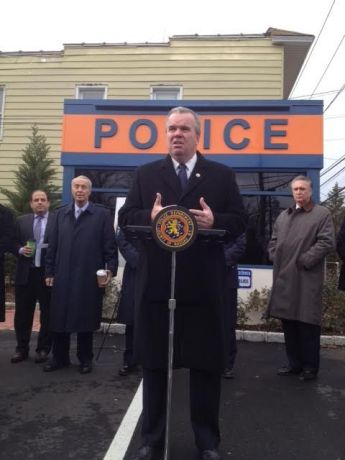Nassau County’s most popular cops are getting some help.
The Nassau County Police Department has established a Community-Oriented Police Enforcement, or COPE, program to tackle quality-of-life crimes and supplement the work of 16 problem-oriented police, or POP, officers.
The department has plans to expand both programs and add at least eight officers between them, Acting Police Commissioner Thomas Krumpter said in an interview last week.
“It pays huge dividends,” Krumpter said. “The community loves it, the elected leaders love it and the executives in this police department love it.”
Six officers and a supervisor were assigned to the program about a month ago, said Detective Lt. Richard LeBrun, commanding officer of the Public information Office.
The force is based at the police headquarters in Mineola and targets low-level offenses, such as open-container violations, underage drinking and narcotics violations, LeBrun said.
Village of East Hills Deputy Mayor Manny Zuckerman said he thinks a force like COPE is “sorely needed” on the North Shore, but wondered whether it would be sufficiently staffed to address problems thoroughly.
“It seems a step in the right direction but I’m just hoping it’s not too little in terms of what we can do,” he said.
The 16 POP officers handle quality-of-life offenses now, but a force dedicated to addressing them — like those in many police departments nationwide — is the “most efficient, strategic way” to increase community policing resources without increasing expenses, LeBrun said.
Rather than assign a few to each of Nassau’s eight precincts, the central location allows COPE officers to “assist any precinct as needed,” he said.
“The commissioner wanted to make sure that our quality of life issues were being investigated and proper enforcement utilized,” he said.
The police department re-launched the POP program last year after many civic leaders, elected officials and residents called for its return.
Before the program was suspended in 2014 as a cost-saving measure, the North Shore’s Third Precinct had four officers assigned to each of its two subdivisions. Each subdivision now has two POP officers.
“We had to focus on the core function, which was responding to calls for emergency service,” Krumpter said.
The POP officers are charged with directly responding to residents’ concerns and forming relationships within the communities they cover.
The COPE force is meant to supplement their work, LeBrun said.
Since March 14, COPE officers have made eight arrests and issued 285 vehicle and traffic summonses and 16 parking summonses, police data shows.
Though they’re not stationed in specific precincts, COPE officers will still attend community meetings and collaborate with POP officers, he said. They will also help investigate burglaries and other crimes.
“They’re going to be very in tune to what the residents are asking for,” he said.
The police department plans to grow both programs from the current 22 officers to at least 30 by the end of the year, Krumpter said.
The specific timeline for expansion is uncertain, he said, but the POP program will likely grow after the summer months.
North Shore village officials and community leaders have raised questions about whether two POP officers in each precinct would give communities the same level of coverage they had at the program’s height.
The COPE program “definitely will be a positive move” as an aid to the POP officers and a line of defense against quality-of-life crimes, said Zuckerman, who oversees the Village of East Hills’ Security Commission.
But he wondered whether COPE officers would be assigned less often to areas with little crime, such as East Hills.
“If they are expanding the program and it’s sizeable enough to be effective, it’s an excellent program, there’s no doubt about that,” Zuckerman said. “But we’ll just have to wait and see how effective it will be and whether they’re going to expand it, and how they’re going to distribute the personnel.”
The ultimate solution to the North Shore’s enforcement is still the reopening of the Sixth Precinct, Zuckerman said.
The Sixth and Third precincts merged in 2012 as a cost-saving move. Led by the Council of Greater Manhasset Civic Associations, community leaders, town and county officials and police union leaders have called for the police department to reopen a fully staffed Sixth Precinct.
They say the area it formerly covered, now the Third North Subdivision, gets less effective police service while the promised cost savings have not been realized.
Krumpter defended the merger in an interview, saying the recent clamor for the Sixth’s return is driven by “agendas.”
The merger has met and exceeded all cost-savings projections, he said, and crime is down 26 percent countywide over the past six years.
“Don’t the taxpayers deserve to garner some benefit by the significant reductions in crime?” Krumpter said.
There are still 177 daily patrols as there were before the merger, and the Sixth Precinct is more than adequately staffed as a community policing center, he said.
A full Sixth Precinct would require 25 new positions the county doesn’t have money for, Krumpter said, and reassigning officers from operational to administrative roles would compromise public safety, he said.
The Third and Sixth Precincts’ detective squads are also working more efficiently as a combined unit, he said.
Police officials continue to evaluate and adjust community policing strategies and learn from other departments around the country, Krumpter said
“We operate under the premise here that just because it’s not broken doesn’t mean we can’t make it better,” he said.
Reach reporter Noah Manskar by e-mail at nmanskar@archive.theisland360.com or by phone at 516.307.1045 x204. Also follow us on Twitter @noahmanskar and Facebook at facebook.com/theislandnow.

